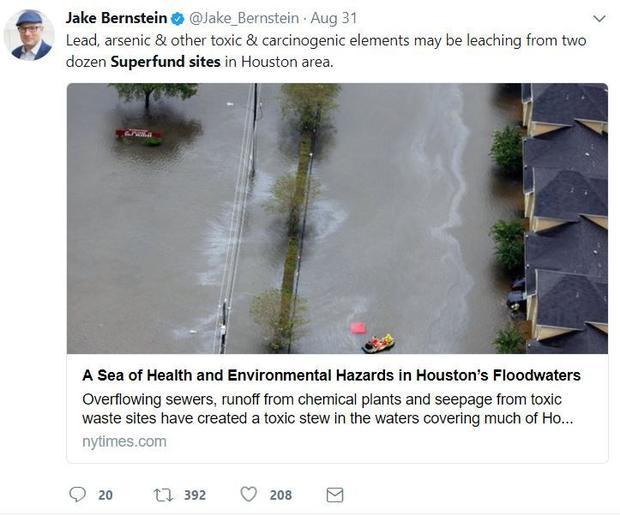When Hurricane Harvey came ashore in September 2017, no one really was prepared for the horrendous amount of rainfall, winds, deaths and destruction the storm left in its aftermath.
First responders were working to save lives, yet they also worried not only about the damage being done by the wind and the devastating rains but about a problem unique to Houston – The petrochemical industry, because after all, the city is one of the country’s leading chemical capitals.
Yes, there were a couple stories about the release of toxic chemicals – like the well-publicized Arkema chemical plant explosion northeast of Houston that blew several times and burned for days and a nearby dioxin-laden federal Superfund site whose protective cap was damaged by the raging San Jacinto River.
According to the Associated Press, Samuel Coleman, who was the EPA’s acting regional administrator during Harvey, said the priority in the immediate aftermath was “addressing any environmental harms as quickly as possible as opposed to making announcements about what the problem was.”
Now, in retrospect, he said, it might not have been a bad idea to inform the public about the worst of “dozens of spills.”
And while first responders were worried about breathing toxins and wading through water that could be contaminated with poisonous chemicals, it turns out their fears were justified. And what’s worse?
The public will probably never know the extent of the damage to the environment and related health impacts caused by the release of the soup of chemicals in Houston.
AP and Houston Chronicle reveal the damage
The Associated Press and the Houston Chronicle pieced together a myriad of county, state, and federal records that reveal a far more widespread toxic impact than what was reported to the public after Hurricane Harvey slammed into the Texas coast, and then stalled over the Houston area.
Besides the nearly half a billion gallons of industrial wastewater that mixed in with flood waters that poured out of a chemical plant in Baytown, East of Houston, and surged into the Bay of Galveston, Benzene, vinyl chloride, butadiene and other known human carcinogens were among the dozens of tons of industrial chemicals released throughout Houston’s petrochemical corridor.
These chemicals mixed with the floodwaters, surging through neighborhoods, and into waterways in the city and surrounding neighborhoods. In all, the two news organizations cataloged over 100 Harvey-related toxic releases — on land, in water and air. Only two of them were reported publicly.
As the Esquire so bluntly puts it, “You mean that local authorities, Scott Pruitt’s EPA, and American corporations downplayed environmental damage? In Texas? In 2017?”
Texas regulators say they have investigated 89 incidents, according to the AP, but have yet to announce any enforcement actions. Testing by state and federal regulators of soil and water for contaminants was largely limited to Superfund toxic waste sites.
Based on widespread air monitoring, including flyovers, officials repeatedly assured the public that post-Harvey air pollution posed no health threat. But the U.S. Environmental Protection Agency official in charge now says these general assessments did not necessarily reflect local “hotspots” with potential risk to people.
In other words, what the EPA is saying is simple – If you want to stay safe, just move to an area where there are no “hot spots.”
Is this laxness a reflection on the federal government?
Both news organizations mention the differences in governmental responses to hurricanes in past years. And post-Harvey government testing contrasts sharply with what happened after two other major Gulf Coast hurricanes.
After Hurricane Ike hit Texas in 2008, state regulators collected 85 sediment samples to measure the contamination; more than a dozen violations were identified and cleanups were carried out, according to a state review.
And in 2005, when Hurricane Katrina hit New Orleans, Louisiana, the EPA and Louisiana officials examined about 1,800 soil samples over 10 months, EPA records showed.
“Now the response is completely different,” said Scott Frickel, an environmental sociologist formerly at Tulane University in New Orleans. He is now at Brown University and calls the government response to Harvey “unconscionable” given Houston’s exponentially larger industrial footprint.
Dr. Nicole Lurie, who oversaw federal public health responses to the Superstorm Sandy and Deepwater Horizon disasters while at the U.S. Department of Health and Human Services told the Associated Press, “People are left in a state of limbo of not knowing if they were exposed or not — or if they were, what the implications are for their health.”
Benzene is a serious health hazard. The Department of Labor’s Occupational Safety and Health Administration (OSHA) says: With exposures from less than five years to more than 30 years, individuals have developed, and died from, leukemia. Long-term exposure may affect bone marrow and blood production. Short-term exposure to high levels of benzene can cause drowsiness, dizziness, unconsciousness, and death.
Hanadi Rifai is the head of the University of Houston’s environmental engineering program, She has been studying pollution in the watershed for more than two decades. She believes that much of the toxic contamination in the floodwaters migrated downstream.
That soil ended up somewhere,” Rifai said. “The net result on Galveston Bay is going to be nothing short of catastrophic.”

















